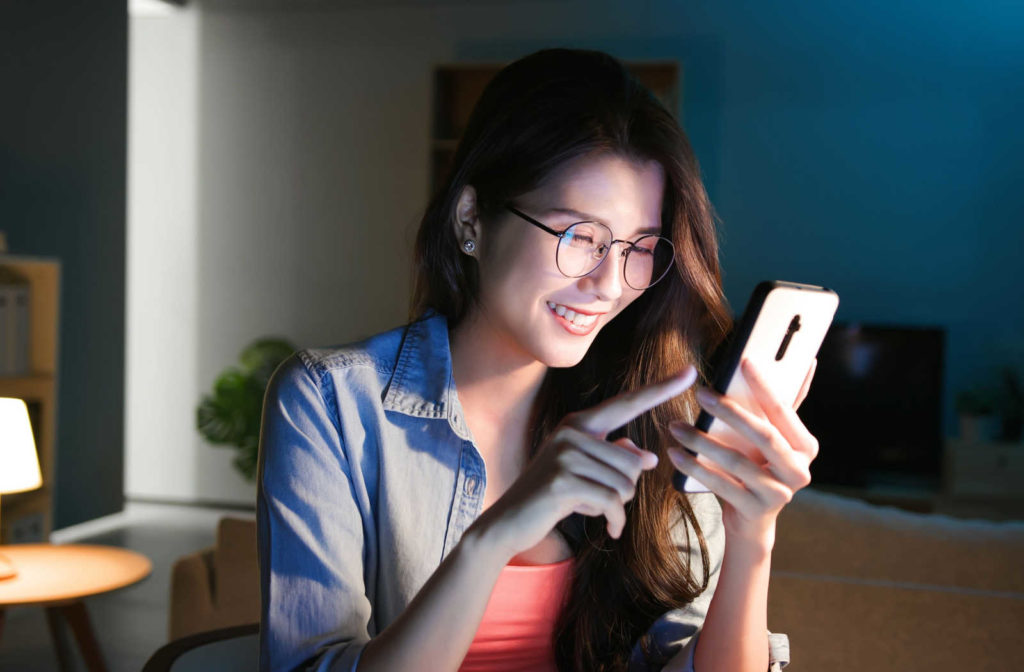Wearing your blue light glasses all the time will not result in negative health effects, but it may not always be beneficial due to how it can change the way colour appears. Knowing how to recognize the signs of digital eye strain can help you learn when to prioritize wearing your blue light glasses.
This becomes a little more complicated if you wear prescription eyeglasses, because you may want to purchase one with and one without a blue light filter. During your examination, ensure you let your optometrist know what your vision needs are. This way they can give you the best recommendation on filters or specialty lenses.
What Is Blue Light?
The visible light spectrum (VSL) is filled with several wavelengths and energy levels of light. Blue light has a shorter wavelength and more energy than other colours on the VSL. One of the primary sources of blue light is the sun, along with the ultraviolet radiation it emits.
Light-emitting diode (LED) bulbs and fluorescent lighting are two additional sources of blue light. But it is important to remember, with the amount of blue light we are exposed to, that it is not all negative.
Positive things that blue light can do include:
- Boost daytime alertness
- Helps elevate mood
- Improved reaction times and attention spans
But even with some subtle health benefits that blue light can provide, current research links long-term, excessive exposure to blue light to an increased risk of several eye-related diseases and conditions:
- Cataracts
- Dry eye disease
- Age-related macular degeneration
Blue Light Glasses
Considering the sheer number of sources, it would be nearly impossible to filter out 100% of blue light. A pair of blue light glasses can certainly help filter out a considerable amount.
If you do not wear prescription glasses or contacts, you can still wear non-prescription blue light glasses that are clear lenses with a blue light filter. These glasses can help prevent symptoms of digital eye strain if the person does not need correction but spends a lot of time on the computer, for example.
When discussing eyeglasses with your eye doctor, you can discuss blue light filters with them. Many lenses are available with blue light filtering coating, UV protection, or anti-glare.

Can I Wear Blue Light Glasses All the Time
It is possible to wear blue light glasses all day without any negative health effects. But one thing to keep in mind is how they can affect the colour of things. When the filter removes the blue light from our visual field, the result is colours that look more yellowish. Depending on the intensity of the filter used, this colour change may be more or less drastic.
If you work in a field or have hobbies that require you to see colours accurately and clearly, wearing blue light glasses all the time may not be beneficial.
What Is Digital Eye Strain
Understanding where you benefit the most from blue light glasses will help you decide when to prioritize wearing them.
Digital eye strain, also known as computer vision syndrome (CVS), is a common condition on the rise, with so many Canadians spending their days on smartphones and computers. Uncorrected refractive errors can be a significant cause for the uncomfortable symptoms of CVS.
While there is no clinical evidence yet that links blue light directly to CVS, we know that blue light scatters light inside the eye and makes it harder to focus, reducing contrast. It is this reduced contrast that can contribute to the symptoms.
Symptoms of CVS can include:
- Blurry vision
- Double vision
- Red, irritated eyes
- Dry eyes
- Headaches or migraines
- Neck or back pain
Preventing Digital Eye Strain
Blue light glasses may be one piece of the puzzle, but they are not a magic fix to prevent CVS. Many people will experience some degree of CVS at some point with how much screen time is required in our daily lives.
There is not a single thing you can do to prevent eye strain, but a few things you can try include:
- Wear the correct, up-to-date prescription eyeglasses
- Adjust lighting to the workspace’s needs—not too bright, but not unlit
- Minimize time spent on screens
- Use artificial tears to ensure your eyes stay hydrated
- Follow the 20-20-20 rule—every 20 minutes, focus on an object 20 feet away for 20 seconds
- Adjust screen lighting and avoid glare
- Position the screen approximately an arm’s length away and slightly below eye level
- Sit up straight
Discuss Blue Light Protection Options With Us
During an eye examination, your eye doctor considers your overall eye health, not just how far or clear you can see. They want to know what your vision needs are. With all the puzzle pieces, they can recommend the best treatment or prevention methods.
So, if you spend a lot of time using digital screens and you want to find out more about your protection options, reach out to our clinic. The professional staff are happy to answer your questions or book you an appointment with one of our eye doctors.




